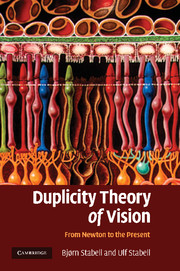Book contents
- Frontmatter
- Contents
- Acknowledgements
- 1 Introduction
- Part I The development of the basic ideas of the duplicity theory from Newton to G. E. Müller
- Part II The development of the duplicity theory from 1930–1966
- Part III Chromatic rod vision: a historical account
- 11 Night vision may appear bluish
- 12 Mechanisms of chromatic rod vision in scotopic illumination
- 13 Rod-cone interactions in mesopic vision
- 14 Further exploration of chromatic rod vision
- Part IV Theories of sensitivity regulation of the rod and cone systems: a historical account
- Part V Factors that triggered the paradigm shifts in the development of the duplicity theory
- References
- Index
14 - Further exploration of chromatic rod vision
Published online by Cambridge University Press: 22 January 2010
- Frontmatter
- Contents
- Acknowledgements
- 1 Introduction
- Part I The development of the basic ideas of the duplicity theory from Newton to G. E. Müller
- Part II The development of the duplicity theory from 1930–1966
- Part III Chromatic rod vision: a historical account
- 11 Night vision may appear bluish
- 12 Mechanisms of chromatic rod vision in scotopic illumination
- 13 Rod-cone interactions in mesopic vision
- 14 Further exploration of chromatic rod vision
- Part IV Theories of sensitivity regulation of the rod and cone systems: a historical account
- Part V Factors that triggered the paradigm shifts in the development of the duplicity theory
- References
- Index
Summary
CONTRIBUTION OF J. J. MCCANN AND J. L. BENTON
Soon after the discovery that rod signals may initiate all kinds of hue, a number of research workers contributed to the further exploration of this phenomenon.
Firstly, McCann and Benton (1969) convincingly demonstrated that rods had the ability to interact with the long-wave cones (L-cones) and thereby produce a multicoloured image. This was illustrated by first illuminating a multicoloured paper with a 656 nm monochromatic light at an intensity level just above the colour threshold in order to activate only the L-cone mechanism. Thereafter, they superimposed a monochromatic light of 546 or 450 nm that activated only the rod receptor system. Adding the scotopic light dramatically changed the colour of the display; red, orange, yellow, blue-green, brown, grey and black could be seen in the display.
A more sophisticated and detailed study of this rod-cone interaction colour effect was later reported by McKee, McCann and Benton (1977). To produce the multicoloured display, a transparent photographic picture was taken both through a red and a green filter and then combined. The display was then illuminated with a red 656 nm monochromatic light at an intensity just above the colour threshold and by one of ten monochromatic lights selected from the 420–600 nm region of the spectrum.
- Type
- Chapter
- Information
- Duplicity Theory of VisionFrom Newton to the Present, pp. 124 - 130Publisher: Cambridge University PressPrint publication year: 2009



